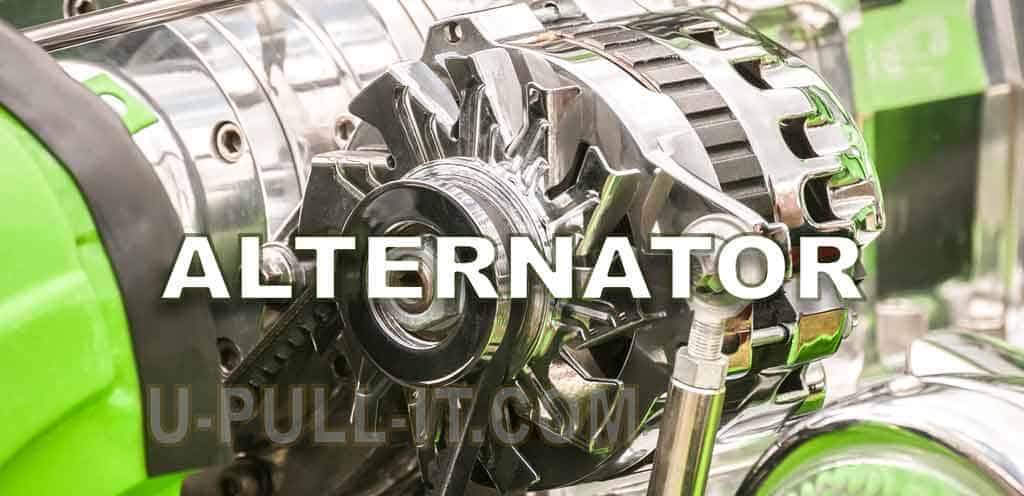When powering up your car, doesn’t only mean you are increasing it’s performance and adding more horse power. When you start or turn on your vehicle and having it stay on it’s the job of the alternator.
The car alternator converts all the mechanical power of the engine into electricity that will run all of your vehicle’s electrical devices. Tuning it up and making sure an alternator it’s working at it’s full potential will also increase the life of your car battery and deliver enough electricity to all your gadgets.
Older vehicles used DC (Direct Current) generators, most newer vehicles use Alternating current or AC. The alternator is used to keep a balanced charge of your vehicle’s battery and at the same time it powers all the various electrical components of your car, like the radio, the lights, if you plugin your cell phone and charge it from your car, that also is being powered by the alternator. The car alternator may not look like a big part of a car ( in size) but without it your vehicle will not be able to function right or at all.
An alternator generally is made of four parts: the rotor, the stator, the diode packs and the very important voltage regulator.
The rotor is made of rotating magnets which rotates around the stator, this has a core made or iron which is wrapped in copper wires. Then the rotor-stator rotate to create the alternating current or AC that is then converted into indirect current by the diode packs, this current it’s used to charge the battery and to power all the electrical devices of your car or truck. The voltage regulator controls and maintains the right amount of electricity that is generated by the alternator, making sure you don’t burn any devices by surges or low power coming out of the alternator.
When you have your alternator rebuilt, you need to make sure you get quality auto parts for it, you don’t want to have defective parts put in and then run out of power while you are driving.
A lot of people start adding gadget that consume more power and their alternator can’t keep up. It’s best you replace it with a more powerful one that can power all of your music amplifiers, speakers, lights, power inverters and other devices you may have added to your car.
HOW TO TELL IF YOUR ALTERNATOR IS FAILING?
If the alternator starts to fail, other things in your car will stop working too. Since the alternator keeps your battery charged and other devices powered while the vehicle is in motion, things will stop operating suddenly.
If you have dimming lights, a fading radio, your car shakes or stalls, then that could be a warning that your alternator is failing.
When your alternator is going bad, you will notice dimer light on your car dashboard, the headlights and even the brightness of the cabin lights will be dimmer. Sometimes you will notice a change of brightness on lights when another device in the car is turned on, for example if you turn on the radio or the Air conditioner. And then when you turn those off the bright light comes back on. This could also mean there are other components that could be causing the power loss and the electrical system in your car needs to be checked.
Electrical System Dimming Down
The alternator powers the car’s numerous electrical / electronic accessories, including power windows and seats, dashboard lights, radio and speakers, computer chips, GPS connectivity, and more. Internet. When things start to darken, disappear, blink or just die, it’s a good sign that your alternator is also dying.
Battery light or check engine light
Most cars come with an engine control light that lights to indicate that something is wrong. There is a standard alignment of things that could be wrong if the engine check light comes on, but if the car has a separate battery indicator, it means something more specific. Some cars have an indicator light on the dashboard labeled ALT or GEN, which is sometimes on the edge of a battery to indicate general power or electricity problems (where your alternator comes in). It’s funny how a little light can change your day, or maybe your life. In this case, the alternator or the battery (or both) have a problem. If all the status lights on the card are lit, it is a sure sign of imminent catastrophic failure.
Dead battery
picture of the car battery with the connected jumper cables. If your car does not start, it is likely that there is a problem with the starter system. If you turn the ignition key and only hear a click, click or nothing at all, it usually means a dead battery. Why is the battery dead? He is old or he is not charged by the alternator.
The work of the battery is to power the starter so that the car starts and all systems work, including the power / charge system. The battery is not designed to be a long-term power source. Even the best new battery will eventually run out with a constant discharge with little or no charge from the alternator. But when the alternator fails, the battery must provide power to the entire vehicle.
However, diagnosing a discharged battery is easy. Start the car, remove the starter cables, let the car run and wait. If the alternator is dead or weak and does not charge the battery correctly, the car will eventually stop. But the best way to determine if the problem is related to an exhausted alternator or an exhausted battery is simply to test the battery with a voltmeter, which can be obtained at maximum in the automatic magazine.





